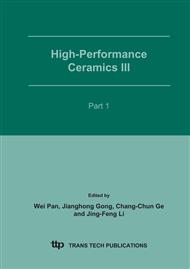p.1889
p.1893
p.1899
p.1903
p.1909
p.1913
p.1917
p.1921
p.1925
The Preparation and Properties of New Silver-Metal Oxide Graded Composite Electrical Contact Materials
Abstract:
Electrical contact material is a very important material for the electric power industry. An electrical contact material should display good structural characteristics (suitable hardness, high thermal conductivity and stabilization) as well as a good functional characteristic (low electrical resistivity). It is difficult to fabricate such a contact material with all these good performing parameters by common techniques because these physical parameters influence each other. In this paper, we report a novel investigation to design and prepare silver-metal oxide composite materials according to functionally layered and graded material (FLGM) concept and meeting requirement as electrical contact material. The silver-based composite samples characterized by layered component were prepared with conventional solid-phase sintering technique. One kind of sample consists of tin dioxide and silver material, in which SnO2 exhibits a graded distribution. Another consists of two metal oxides, cadmium and zinc oxides, and silver material, in which each layer has different metal oxide. Hardness, thermal conductivity and electrical conductivity, were measured and related problems are discussed. Especially, welding resistance as an important parameter for practical application was tested. SEM analyses before and after electrical erosion were also performed. We conclude that the functionally graded material (FGM) concept as a novel designing and fabricating method has potential for electrical contact composite material.
Info:
Periodical:
Pages:
1917-1920
Citation:
Online since:
February 2007
Authors:
Price:
Сopyright:
© 2005 Trans Tech Publications Ltd. All Rights Reserved
Share:
Citation:


